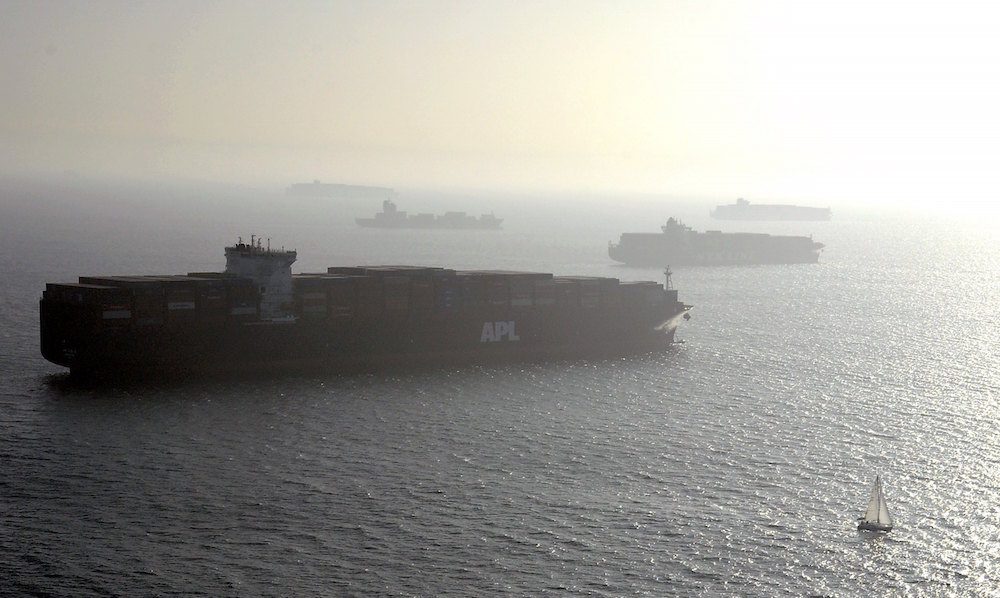Port of Rotterdam’s Throughput Falls Amid Global Tensions
Europe’s busiest port, the Port of Rotterdam, saw a decline of 1.4% in its total throughput in the first quarter of 2024 compared to last year. In total, the port...


Ships gather off the ports of Los Angeles and Long Beach, California as a sailboat makes it way past them in this aerial photo taken February 6, 2015. REUTERS/Bob Riha Jr
By James Nash
(Bloomberg Business) — The West Coast ports of the U.S. are headed for paralysis as a contract dispute between management and unionized dockworkers spills onto the docks from San Diego to Bellingham, Washington. Labor Secretary Tom Perez this week joined talks between the Pacific Maritime Association, which represents management, and the 20,000-member International Longshore and Warehouse Union. The talks have failed to produce an agreement after nine months. What’s at stake?
West Coast ports are responsible for more than 43 percent of U.S. trade, according to the Pacific Maritime Association’s annual report, and 12.5 percent of the U.S. gross domestic product. A closing would cost the U.S. economy as much as $2 billion a day, the association said, citing figures from a 2002 lockout that lasted 10 days and cost roughly $1 billion a day.How much does a dockworker make?
On Feb. 4, management made details of its contract offer public, including 3 percent annual raises and maintaining employer-paid health care and pension programs. The average unionized dockworker currently makes $147,000 a year, according to the management press release.
The union disputes that figure, saying it assumes significant overtime and includes non-salary benefits. Most dockworkers take home less than $100,000 a year, it says. What’s holding up a deal?
The last significant roadblock is the union’s demand to be able to unilaterally fire arbitrators who hear workplace grievances, said James McKenna, president of the management group. The union has declined to comment on this alleged demand.
These negotiations are always fraught. The 2008 talks — the only ones between 2002, when port employers ordered a lockout of the dockworkers, and the current brinksmanship — weren’t especially acrimonious, but the talks are never done before the contract expires. What’s happening at the ports right now?
The slowdowns have reduced cargo movement by almost half at the largest ports, leaving more than 30 cargo ships stranded in the harbor shared by the Los Angeles and Long Beach ports and cargo containers piled up on the docks. The Pacific Maritime Association, the bargaining agent for shipping lines, terminal operators and stevedores, suspended cargo operations for six days in February — all weekends or holidays — instead of paying overtime for what it said was diminished productivity. Those actions have contributed to the backups.And at the bargaining table?
The two sides negotiated by themselves until January, when they agreed to bring in a federal mediator. The mediator was unable to foster an agreement. Labor Secretary Perez joined the talks Tuesday.What’s next?
Without a contract, the union can strike and port employers can order a lockout, as they did in 2002 after accusing dockworkers of deliberate slowdowns. If either happens, the White House could invoke the Taft-Hartley Act to reopen the ports, as George W. Bush did after the 2002 lockout stretched to 10 days.
Copyright 2015 Bloomberg.
Join the gCaptain Club for curated content, insider opinions, and vibrant community discussions.


Join the 105,983 members that receive our newsletter.
Have a news tip? Let us know.
Access exclusive insights, engage in vibrant discussions, and gain perspectives from our CEO.
Sign Up




Maritime and offshore news trusted by our 105,983 members delivered daily straight to your inbox.



Essential news coupled with the finest maritime content sourced from across the globe.
Sign Up